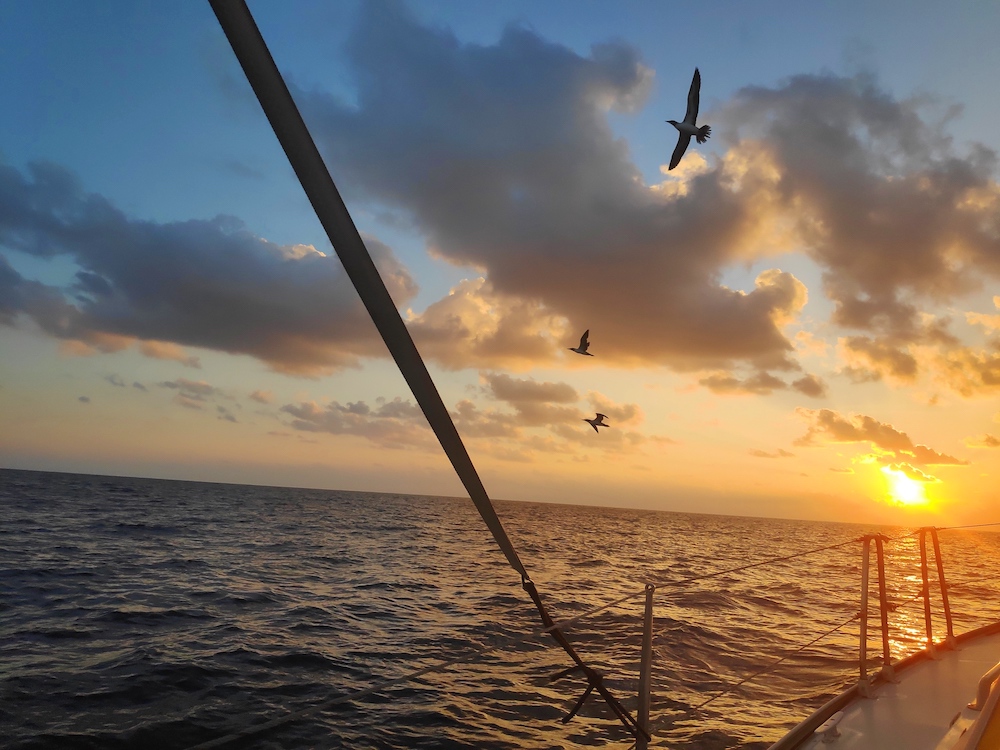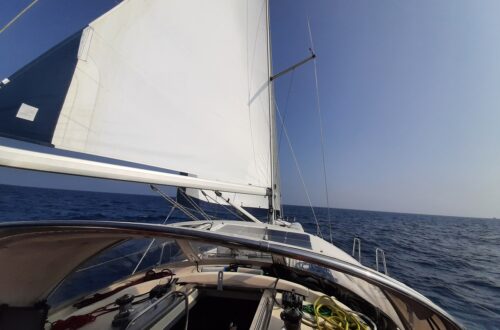
Do You Anchor Overnight?
There were a few consistent questions asked by others as we were preparing to sail. One that frequently cropped up was what we would do at night. Many assumed that we would anchor up, sleep and continue the next day. But on a long-distance sail, there is nowhere to stop and no other choice than to keep going – day and night for as long as it takes. As I write this, on passage in our current position, the depth is 2800 metres. It is almost inconceivable the ocean can be that deep, but one thing is for sure – it is too deep to anchor!
With any long-distance passage – Dubai to Kochi took 15 days – the simple reality is that you just keep going day and night. The nights are long 6 pm to 6 am, and with just the two of us on-board the most sensible solution is 3-hour watches throughout the night. While one of us is on watch, the other will sleep, and we swap every 3 hours. We used to say that you get used to it after a few nights, that it gets easier but I am not sure that it does. But with no other option, here is how we cope…..
The handover starts by giving the newly awakened person a few minutes to become fully conscious – sometimes you just go for semi-conscious and hope the coffee kicks in soon! There is nothing worse though than being half-awake having information fired at you if you are not taking it in. The handover briefing includes any notable events during the past 3 hours, alerting to any ships showing on the AIS tracker that need to be watched and any changes in conditions such as wind direction, speed etc.
Towards the end of our 3-hour watch, we will prepare a drink for the person coming on watch and then wake the other up. We decided after a few nights to take the wake-up drink preference order, that way the drink is prepared as per the request and ready to go without the need to ask your groggy better half what they want. It only gets a bit challenging when your other half thinks they are ordering from an all-night diner menu and instead of “do you want coffee or tea” you get a request for a cold coffee, chilled in the fridge before serving. Once done, you can head down to catch your 3 hours sleep before it’s your turn again. Brutal!
The watch is considered to be either active or standby. An active watch is during lively weather or where there is a lot of shipping traffic or fishing nets and needs a constant lookout throughout the entire watch. On the standby watch there will be fewer ships and better conditions. During this time, it is accepted that if you are on watch you will be able to do other activities to help fill in the time, for example reading a book or watching a movie. However, the unconditional rule is that we have a kitchen timer set to go off every 15 minutes and as the alarm sounds you do a 360-degree scan of the horizon to see if any vessels can be seen and also check the AIS system. The AIS is essentially an early warning system. The majority of large vessels are equipped with it and most long-distance smaller boats such as us.
The AIS receives position and vessel data information via VHF of all boats in the vicinity and sends our information to them. This means that other boats can “see” us, and we can see them while in the VHF range, which can be up to 30 miles depending on the conditions. It lets us see the name of the boat, its size, the direction of travel, speed and destination port along with the current distance from us and its predicted position in 30 minutes time. Now and again, the course of a ship looks like it is going to get too close for comfort. Bear in mind we are like a speck of dust in the eye of the ocean when up against ships of 1,000 metres plus. If in doubt, we will call up the ship on VHF, just to make sure that they know we are there. It is reassuring to hear them say they can see us on VHF and radar and will be well clear of us. Well clear is usually a mile away, in the daylight this is interesting to see them pass at relatively close quarters but far more disconcerting at night.
Three hours watch and three hours sleep is the timing that works for us. The first few nights are tough. They never get easy, but they do get easier. Our first few nights leaving Dubai were very much active watches. Within hours of leaving DOSC we were dodging fishing nets off the top of Palm Deira. There are different techniques used by local fishermen. Some use large metal cages that look like oversized lobster pots. These drop to the ocean floor and are marked at the surface by plastic or foam floats. These are not too much of an issue, best avoided if possible but not likely to cause too much of a problem. The ones which are a real challenge are the nets strung between 2 points – essentially creating a long curtain of net suspended in the water by a series of small plastic buoys a metre or so apart. These nets can span hundreds of metres. Sometimes they are marked by flashing lights to indicate where they start and finish, but many have nothing but are guarded by small fishing boats who tear around using flashlights on the water to indicate where the nets are. Many do this really badly and it is incredibly confusing to work out which direction we need to head in to avoid them. If we run over one of these, we are in danger of them getting trapped around our propeller. We have a rope cutter on our prop, which depending on what type of rope it encounters it can cut through, but with a long line of fishing net it wouldn’t stand much of a chance.
Once away from the Palm, it was a more or less straight run-up towards Musandam and the Strait of Hormuz. Tensions with Iran have rendered this a conflict zone. At its narrowest point, it is only 39 km between Oman and Iran so for safety sake, we wanted to travel through the Strait in daylight. To achieve this, we motor-sailed along the west coast of the UAE and passed through the Strait with no issues around midday. On the east coast of Musandam heading back towards the UAE there is a lot of shipping traffic heading to the ports of Fujairah and Khorfakken, and then later into the Oman ports. This made the first three nights out of Dubai challenging. The wind was heading directly at us for most of the route also, which resulted in us continuing to motor sail. We also hit a rough patch of weather running parallel with Muscat in the Gulf of Oman. With heavy rain and winds gusting up to 30 knots and a very messy disturbed sea with waves 2-3 metres neither of us was having much fun. Alternating between sailing and motoring we reduced the sail area to make sure we were not overpowered by the wind. All of these events meant active watches. There was no sitting with the kitchen timer waiting for our 15-minute 360-degree check. We were on constant lookout.
Thankfully these watches are the extreme and when conditions are calmer and there is less traffic we are able to do other activities during the 15-minute intervals between lookouts. The kitchen timer is there to wake you up if you do inadvertently doze off.
When you are a 37ft tiny dot of plastic in a great big ocean it seems almost inconceivable that 2 boats can end up in the same space at the same time, but as with any form of travel, you typically want to take the course that requires the least amount of distance travelled which invariably means there are channels of traffic heading back and forward along similar paths between shared destinations.
Any night time activities need to protect night vision by avoiding bright lights and by using a red light if reading or getting something from the cabin. We wear head torches throughout our watches that have a night light function. This means that when we do our visual check, our eyes adjust more easily to looking out into the darkness. Technology is great for giving us advance warning of boats heading in our direction but is not fail-safe. The visual check helps us to see if there is anything no displaying an AIS signal or to confirm the location of a boat that we were expecting to see. We also look for the shipping navigational lights which tell us which direction a boat is headed.
Reading tends to send me to sleep, so on the India passage, I trialled audiobooks for the first time, making sure that I have only one headphone earbud in, so I can still listen with the other. It worked pretty well and really enjoyed The Whisper Man by Alex North. I did pretty well on Human Universe by Prof Brian Cox, described as an uplifting journey of the big questions that has taken humanity from ape-man to space-man although not sure the astrophysics really went into my tired brain. To be fair, much of it would have sailed over the top of my fully alert brain too, but I was glad I gave it a go. I also found writing keeps my brain active. Many of these blogs posts were written on a night watch – so I can be forgiven for the ramblings of a madwoman who thought it all made sense at stupid o’clock in the night after a few hours sleep.
Another consideration on night watch is safety. On long passages, we wear self-inflating life jackets are all times – literally 24-7. The only time we remove them is to take a shower. We are also tethered to the boat with lifelines – about 2 metres of a thick strap with a clip either end. One is tethered to steel hooks in the centre of the cockpit and the other to our life jacket. These lines are long enough to allow us to move around the cockpit unrestricted but too short to allow us to fall overboard. The Robert Redford film “All is Lost” shows him wearing a lifeline, yet he falls overboard several times resulting in him being dragged along in the water. A classic “how not to do it”. The film has a number of other sailing faux pas. The most ridiculous of which is when he lights a fire in his life raft after sinking his yacht. He was meant to be doing it to attract help but unsurprisingly only manages to sink that too. Not the smartest thing to do, but hey that’s Hollywood for you!
Despite the mental and physical challenges that sailing day and night brings, it is a necessary yet totally unique experience. There is one thing that does make up for it though is that you get to experience amazing sunrises and sunsets, and the chance to really enjoy them with nothing but you and the boat and the horizon. Bliss!
Follow and like us to be notified of future blogs!






One Comment
Jacqui ONeill
Brilliant read 👍